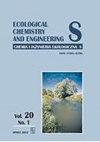Physiological Perspective of Starch as a Carbon Source in Two Varieties of Carya illinoinensis Koch in Northern Mexico
IF 2.5
4区 环境科学与生态学
Q3 ENVIRONMENTAL SCIENCES
Ecological Chemistry and Engineering S-Chemia I Inzynieria Ekologiczna S
Pub Date : 2023-09-01
DOI:10.2478/eces-2023-0033
引用次数: 0
Abstract
Abstract The study took as a purpose to determine the Total Carbon (TC) content in the biomass, the Starch Carbon fraction (SC) and its annual dynamics in the biomass of perennial organs (stem and root) in adult trees of two of walnut tree ( Carya illinoinensis ). Four adult Western and Wichita tree stem and root samples were carried out monthly for a whole year. The TC was determined with an elemental analyser and the SC has gotten based on the molecular mass of the glucose (0.40 gC/gGlucose). t -Student test was performed between varieties per organ for the comparison of TC and SC through the program SPSS 15.0 with a significance of p ≤ 0.05. The results in Western variety were 160.02 kg TC and 4.90 kg SC to 7.54 kg SC in the stem; 64.58 kg TC and 1.74 kg SC to 3.09 kg SC in the root; in Wichita variety were presented 119.72 kg TC and 4.49 kg SC to 6.83 kg SC in the stem; 45.72 kg TC and 1.35 kg SC to 2.75 kg SC in the root. The root was the organ where the greatest amount of SC was stored in relation to the stem, due this latter constitutes a transport organ. Temperature has a marked inversely proportional influence on the accumulation of SC in both varieties. Global solar radiation and solar radiation proportionally influence the accumulation of SC.墨西哥北部两个山核桃品种淀粉作为碳源的生理研究
摘要本研究旨在测定两种核桃成树多年生器官(茎和根)生物量中总碳(TC)含量、淀粉碳分数(SC)及其年动态。4棵成年西部和威奇托树的茎和根样本每月进行一次,为期一年。TC用元素分析仪测定,SC根据葡萄糖的分子质量(0.40 gC/葡萄糖)计算。采用SPSS 15.0软件在各器官品种间进行t -Student检验,差异有显著性,p≤0.05。西部品种茎部总重量为160.02 kg,茎部总重量为4.90 ~ 7.54 kg;根中烟碱64.58 kg, SC 1.74 kg ~ 3.09 kg;威奇托品种茎部总总重量为119.72 kg,茎部总重量为4.49 ~ 6.83 kg;45.72 kg TC, 1.35 kg SC ~ 2.75 kg SC。相对于茎,根是储存最多SC的器官,因为茎是运输器官。温度对两个品种的SC积累有显著的反比影响。太阳总辐射和太阳辐射成比例地影响SC的积累。
本文章由计算机程序翻译,如有差异,请以英文原文为准。
求助全文
约1分钟内获得全文
求助全文
来源期刊
CiteScore
2.80
自引率
36.80%
发文量
32
审稿时长
>12 weeks
期刊介绍:
The quarterly Ecological Chemistry and Engineering S is a multidisciplinary journal devoted to the publishing of original scientific papers, review articles, professional papers, case reports and varia (professional information, book reviews, etc.).
It is pertinent to describe methods determining quality of air, water, soils and food.
Many papers published are on monitoring and biomonitoring of an environment and on transfer of pollutants (eg heavy metals or radionuclides) from soil to plants. Some Authors consider impact of environment pollution on food and human health.
Some papers describe models of pollutant spreading in air or within soil. Others are devoted to various technologies to prevent or minimize industrial pollution, as well as to remediation techniques.
Papers on renewable energy sources are also very welcome.

 求助内容:
求助内容: 应助结果提醒方式:
应助结果提醒方式:


